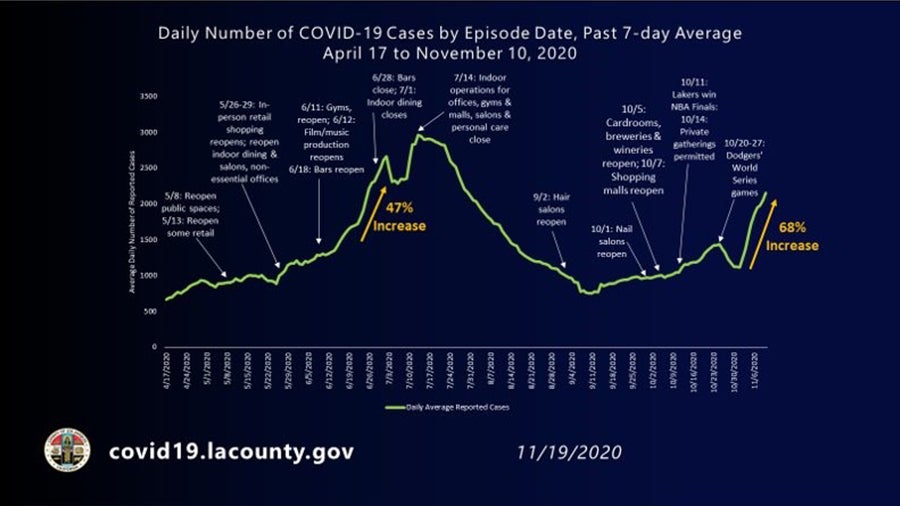L.A. City and County COVID-19 Weekly Update (November 23, 2020)
A Dangerous COVID-19 Surge
Last week, Los Angeles County experienced what the County Department of Public Health described as “a dangerous acceleration of cases.” The increase in new cases last week outpaced the highest rates in the County at any time during the COVID-19 pandemic, including during the surge in July. In a press release issued on Thursday, November 19, 2020, the County noted: “From June 20 through July 3, the 7-day average increase in new cases was 47%. From October 28 through November 10, the 7-day average increase in new cases is surging at 68%.”

The County remains in Tier 1 of the State’s Blueprint, along with 42 of the state’s 58 counties, covering approximately 94% of the state’s population, after the Governor moved several counties back from reopenings in what he called pulling the “emergency brake” on Monday, November 16, 2020.
New Restrictions
On Tuesday, November 17, 2020, the County announced new restrictions on businesses and private gatherings, in an effort to control the surging COVID-19 infection rates. These restrictions went into effect on Friday, November 20, 2020, unless otherwise noted below.
Retail, Personal Care and Entertainment
- For nonessential businesses permitted to operate indoors—including retail stores, offices and personal care services—occupancy will be limited to 25% of maximum capacity.
- The number of customers at entertainment centers (cardrooms, outdoor mini golf, go carts and batting cages) will be limited to 50% of maximum outdoor capacity.
- Services at personal care establishments may only be provided by appointment and only to customers wearing face coverings by staff wearing face coverings.
- Services that require either the customer or the staff to remove their face covering, such as facials and shaves, are not permitted.
- Food and drinks cannot be served to customers at retail or personal service establishments.
- The number of patrons at outdoor restaurants, breweries and wineries will be limited to 50% of maximum outdoor capacity until November 25, 2020, at 10 p.m., after which all restaurants, breweries, wineries and bars are closed for both indoor and outdoor service through at least December 16, 2020. These establishments can continue operations for retail, drive-through, pickup and delivery only.
- On Sunday, November 22, 2020, L.A. County Department of Public Health announced the closure of all restaurants, breweries, wineries and bars for both indoor and outdoor service.
- Restaurants, breweries, wineries, bars and all other nonessential retail establishments must close from 10 p.m. to 6 a.m.
- Note that this restriction was pre-empted by the State’s new Limited Stay at Home order, including a mandatory curfew between 10 p.m. and 5 a.m. for all counties in Tier 1 of the Blueprint, which went into effect on Saturday, November 21, 2020, and runs through December 21, 2020.
- Outdoor gatherings remain the only gatherings permitted, and they must only include 15 people maximum who are members of no more than three households.
Hospital Capacity
On Wednesday, November 18, 2020, L.A. County Health Services Director Dr. Christina Ghaly presented on the County’s hospital capacity and testing. She stated that the County’s transmission rate (R) has risen to 1.18, a “marked increase” from last week’s estimated rate of 1.03. The highest rate experienced in L.A. County during this pandemic was 1.26, in late June. On Sunday, November 22, 2020, the County Department of Public Health posted the graphic below, showing the sharp increase in hospitalizations over the past several weeks.

Dr. Ghaly also said that the County has experienced a significant increase in new hospitalizations, with the daily new patient number nearly doubling since September. The County has seen a daily increase in the number of people hospitalized due to COVID-19 nearly every day in the month of November. Based on both this estimated transmission rate and current infection trends, Dr. Ghaly said that it is “highly likely” that the County will soon see the highest hospitalization rates to date during this pandemic. Even with significant changes in behavior, there will likely be major increases in the number of hospitalizations in the next two to three weeks, and while hospital capacity remains adequate, the County’s model now predicts an increasing number of new cases that may overwhelm hospital capacity and specifically ICU capacity. Dr. Ghaly cautioned that while County hospitals have capacity to “flex up” their beds and equipment, staffing (particularly ICU staffing) is not as flexible and is not an unlimited resource.
